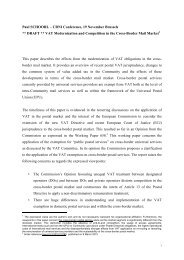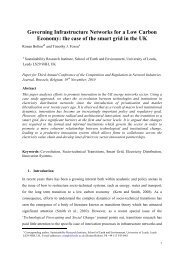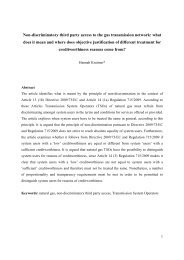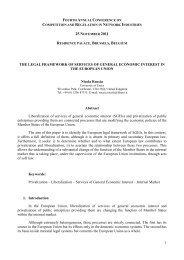Regulatory Incentives for Investments in Electricity Networks - CRNI ...
Regulatory Incentives for Investments in Electricity Networks - CRNI ...
Regulatory Incentives for Investments in Electricity Networks - CRNI ...
Create successful ePaper yourself
Turn your PDF publications into a flip-book with our unique Google optimized e-Paper software.
R t = R t-1 (1 + CPI t - X)<br />
where:<br />
R t<br />
CPI<br />
X<br />
t<br />
is the limit on prices, or on revenue<br />
is the growth rate of a general (consumer) price <strong>in</strong>dex<br />
is a factor that reflects the assumed rate of efficiency <strong>in</strong>creases and other relevant<br />
factors<br />
is the year <strong>in</strong>dex<br />
This <strong>for</strong>mula shows that the cap or upper limit on either revenue or prices <strong>in</strong> the current year,<br />
year t is set equal to:<br />
• the upper limit <strong>in</strong> the previous year;<br />
• adjusted <strong>for</strong> general price <strong>in</strong>flation (the “CPI” term) and the assumed <strong>in</strong>crease <strong>in</strong> efficiency net of<br />
the effect of other factors (the “X” term)<br />
This is the essence of cap regulation, though <strong>in</strong> practice other variables tend to be added to the<br />
<strong>for</strong>mula. Often these variables represent costs that are passed through <strong>in</strong> full to the consumer,<br />
usually because they are outside the control of the service provider. They may also represent<br />
costs related to a per<strong>for</strong>mance target, e.g. the allowance <strong>for</strong> network losses where the target is a<br />
specified percentage of network losses. We provide further details on the application of caps <strong>in</strong><br />
the next sections.<br />
3.3 Yardstick Regulation<br />
The third general category of price control regulation is yardstick regulation. Under this<br />
regulation prices or revenues are l<strong>in</strong>ked to the average <strong>in</strong>dustry per<strong>for</strong>mance. Yardstick<br />
regulation is not, or at least not completely, based on an assessment of the cost position of<br />
<strong>in</strong>dividual service providers but upon a comparison of prices or cost positions and cost<br />
determ<strong>in</strong>ants between firms. 7 For example, under a "yardstick" mechanism based on cost<br />
<strong>in</strong><strong>for</strong>mation, service providers are not allowed to charge higher prices than a particular statistical<br />
mean that is calculated over costs of all service providers, unless perhaps different prices were<br />
justified by their "special operat<strong>in</strong>g conditions".<br />
Yardstick regulation <strong>for</strong> electricity distribution is currently applied <strong>in</strong> Norway and the<br />
Netherlands, though <strong>in</strong> quite different <strong>for</strong>ms. The Norwegian model partially l<strong>in</strong>ks the allowed<br />
revenue to a cost norm. The cost norm is set annually us<strong>in</strong>g benchmark<strong>in</strong>g analysis and tak<strong>in</strong>g<br />
<strong>in</strong>to account any differences <strong>in</strong> external conditions. The benchmark<strong>in</strong>g <strong>for</strong> electricity distribution<br />
applies a Data Envelopment Analysis (DEA) us<strong>in</strong>g a national data sample.<br />
7 For a discussion of the theoretical effects of yardstick regulation see <strong>for</strong> example Tangerås (2002), Yatchew<br />
(2001), Weyman-Jones (1995) or Shleifer (1985).<br />
6







